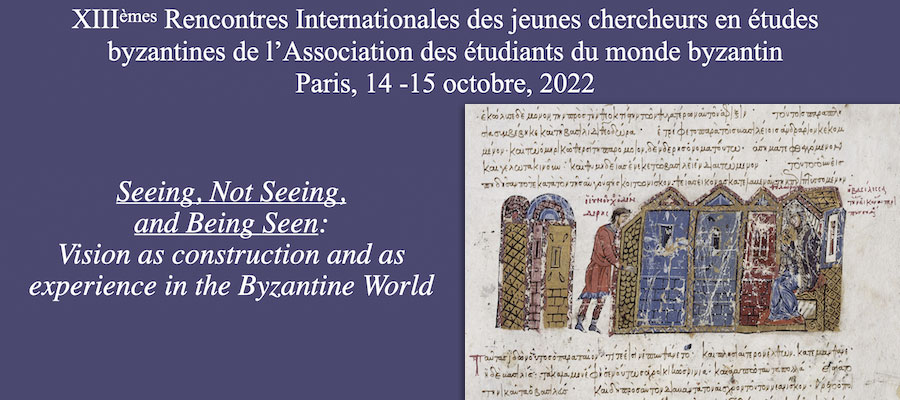Seeing, Not Seeing, and Being Seen: Vision as Construction and as Experience in the Byzantine World, XIIIe édition des rencontres internationales des jeunes chercheurs de l’AEMB, Institut national d'histoire de l'art (INHA), October 14–15, 2022
For the 13th edition of the Association des étudiants du monde byzantin international post-graduate conference, the selected theme is Visuality.
In a well-known episode, reported notably by Zonaras in the 12th century, the dwarf Denderis surprises the empress Theodora while she is venerating icons, unbeknownst to her husband. When she is interrogated by the emperor, she responds to him saying that Denderis was mistaken, and that he saw the reflection of her “beautiful dolls” in the mirror, whose forms he did not recognize. This episode puts ideas of view and perception into play, in a dialectic that calls on the visible and the invisible: the icons, essential to the cult, invoke the presence of a God whose visibility is made possible through the Incarnation and, consequently, through these sacred images; reserved solely for the eyes of the empress, they are, in the iconoclast context, conserved out of sight. When Theodora incriminates Denderis in front of her husband, she insinuates that his vision was faulty, resulting in an incorrect interpretation of a reflection in the mirror. The different facets of this literary staging of vision attest to the importance accorded to sight, the predominant sense according to the Byzantines, before that of hearing.
The very rich Greek vocabulary pertaining to vision links several aspects of the phenomenon. First, there is a bodily dimension, since it is a sensory phenomenon which mobilizes the body of the viewer, to which a role of projection or reception is given depending on whether one favors the theory of extramission or that of intromission (both debated by the Byzantines without interruption from Late Antiquity to the Palaiologan period). A tool for knowledge, the eye makes it possible to grasp different phenomena of the visible world. It summons scientific, medical, and moral discourses: blindness can be considered as a refusal of God. Deprivation of sight is also a means of repression, frequently used by emperors (and empresses) to chastise their disgraced enemies and to disqualify pretenders to power. The role of vision is found even in rhetorical culture, where authors use visual effects to guide the reader’s gaze, the most famous process being that of ekphrasis, a description aimed at transporting the reader in front of the object or event that is being discussed.
The role of vision in cognitive phenomena is also affirmed, since the imprint in the mind of things seen can be used for memorization and for conceptualization, giving rise to mental images which can be tools for understanding. In this respect, the homily delivered by Photios at Hagia Sophia on March 29, 867 is compelling: the author closely associates perception by sight with the fixation of knowledge into memory. This conceptualization through the eyes of also constitutes a means of accessing an inaccessible truth, notably the divine mystery, through sensory perception. These mental images also take the form of dreams or illusions – a frequent theme in hagiographic texts – the understanding of which may require exegetical work: this unveiling may be a divine ordinance or a warning about the future, of which the most extreme form is the apocalyptic vision.
Finally, the social and collective dimension of vision must be taken into account. One need only look to the imperial milieu to understand the role of ceremonies and the staging of power in the public space. This incarnation of power equally concerns the Church; the place of vision arises in devotional and liturgical practices, which grant images a primordial function in intercession and which unite the concepts of visuality and the sacred, reserving certain rites for the sight of the celebrant alone. Architecture and monumental decoration participate in the construction of visual experience by establishing limits to what is visible or not, according to the status of the viewer and his position in space. This phenomenon attests to the socially constructed nature of the gaze, which focuses on certain figures and marginalizes others.
It is this central role of visuality in Byzantine epistemology and culture that the 2022 international post-graduate conference in Byzantine Studies will explore.
